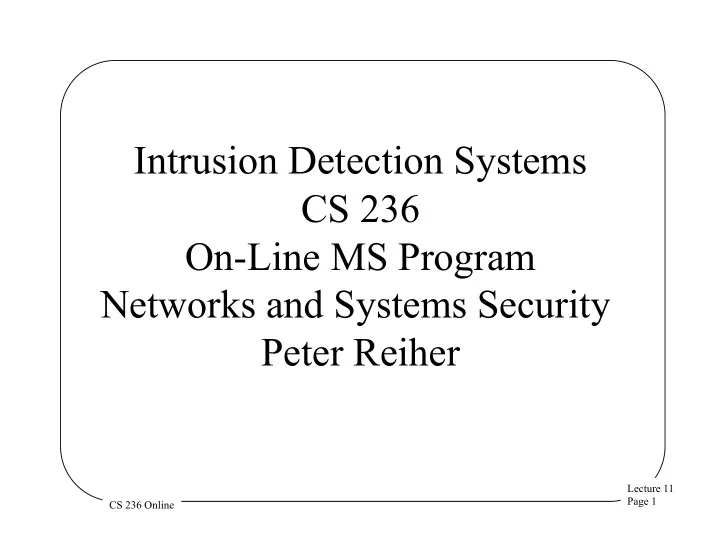

Intrusion Detection Systems CS 236 On-Line MS Program Networks and Systems Security Peter Reiher Lecture 11 Page 1 CS 236 Online
Outline • Introduction • Characteristics of intrusion detection systems • Some sample intrusion detection systems Lecture 11 Page 2 CS 236 Online
Introduction • Many mechanisms exist for protecting systems from intruders – Access control, firewalls, authentication, etc. • They all have one common characteristic: – They don’t always work Lecture 11 Page 3 CS 236 Online
Intrusion Detection • Work from the assumption that sooner or later your security measures will fail • Try to detect the improper behavior of the intruder who has defeated your security • Inform the system or system administrators to take action Lecture 11 Page 4 CS 236 Online
Why Intrusion Detection? • If we can detect bad things, can’t we simply prevent them? • Possibly not: – May be too expensive – May involve many separate operations – May involve things we didn’t foresee Lecture 11 Page 5 CS 236 Online
For Example, • Your intrusion detection system regards setting uid on root executables as suspicious – Yet the system must allow the system administrator to do so • If the system detects several such events, it becomes suspicious – And reports the problem Lecture 11 Page 6 CS 236 Online
Couldn’t the System Just Have Stopped This? • Perhaps, but - • The real problem was that someone got root access – The changing of setuid bits was just a symptom • And under some circumstances the behavior is legitimate Lecture 11 Page 7 CS 236 Online
Intrusions • “any set of actions that attempt to compromise the integrity, confidentiality, or availability of a resource” 1 • Which covers a lot of ground – Implying they’re hard to stop 1 Heady, Luger, Maccabe, and Servilla, “The Architecture of a Network Level Intrusion Detection System,” Tech Report, U. of New Mexico, 1990. Lecture 11 Page 8 CS 236 Online
Kinds of Intrusions • External intrusions • Internal intrusions Lecture 11 Page 9 CS 236 Online
External Intrusions • What most people think of • An unauthorized (usually remote) user trying to illicitly access your system • Using various security vulnerabilities to break in • The typical case of a hacker attack Lecture 11 Page 10 CS 236 Online
Internal Intrusions • An authorized user trying to gain privileges beyond those he should have • Used to be most common case • No longer the majority of problems – But often the most serious ones • More dangerous, because insiders have a foothold and know more Lecture 11 Page 11 CS 236 Online
Information From 2010 Verizon Report 1 • Combines Verizon data with US Secret Service data • Indicates external breaches still most common • But insider attack components in 48% of all cases – Some involved both insiders and outsiders 1 http://www.verizonbusiness.com/resources/reports/rp_2010- data-breach-report_en_xg.pdf Lecture 11 Page 12 CS 236 Online
Recommend
More recommend